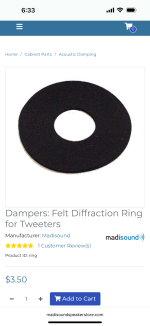So I had a similar issue with a tweeter years ago. The fix was a tweeter felt ring from Madisound. Or go to a hobby store and cut one out your self. It should have self adhesive on the back. Here’s a picture. It’s a cheap and simple solution. Also a lot of these manufacturers use clad aluminum wire. I found it in my linn speakers of all companys. 😱😞. In their book shelf speakers. I hope this helps? JeffI have some B&W DM 602 S1 speakers. They're about 28 years old. I like their performance, but I've always found them to have a high-frequency range that gets fatiguing during extended listening. I tried the crossover modifications suggested here on diyAudio, but quickly went back because I noticed the original crossover is better. I've now seen a pair of DM 602 S3 tweeters for sale. They can be improved over the original DM602 S1. The other thing is that the ferrofluid is probably old by now. The question is: will replacing the tweeter with the S3 tweeter change the sound for better or worse? Regards.
I almost forgot to mention. The only time I heard a difference in the sound of speakers with caps is when I replaced ones that were from the beginning of the 70s. In my dad’s Sansui speakers. I used all dayton Audio caps and resistors and new binding post. I did solder new wire to the binding post. Only $4.99 each. They must have been dried out from the dry leakage on the sides of the caps and resistors.
Attachments
Last edited:
BTW, I've tried felt rings and capacitor replacements. They are good when you have an itch to scratch. For twetters that have small, ragged peak and dips. If the OP's speakers measure as in the S&V review though he'll need to tame that 9kHz peak first. Then a cap swap may be the icing on the cake.
BTW, B&W uses Mundorf caps in a way to distinguish their higher end offerings, so after all is said and done, if the OP tames that peak to his satisfaction and still wants to play with caps, the MKP line is inexpensive and reasonably small. A good additional learning exercise.
BTW, B&W uses Mundorf caps in a way to distinguish their higher end offerings, so after all is said and done, if the OP tames that peak to his satisfaction and still wants to play with caps, the MKP line is inexpensive and reasonably small. A good additional learning exercise.
I will try to do itSo I had a similar issue with a tweeter years ago. The fix was a tweeter felt ring from Madisound. Or go to a hobby store and cut one out your self. It should have self adhesive on the back. Here’s a picture. It’s a cheap and simple solution. Also a lot of these manufacturers use clad aluminum wire. I found it in my linn speakers of all companys. 😱😞. In their book shelf speakers. I hope this helps? Jeff
I almost forgot to mention. The only time I heard a difference in the sound of speakers with caps is when I replaced ones that were from the beginning of the 70s. In my dad’s Sansui speakers. I used all dayton Audio caps and resistors and new binding post. I did solder new wire to the binding post. Only $4.99 each. They must have been dried out from the dry leakage on the sides of the caps and resistors.
So here’s an idea So years ago I heard some cables That did clean up the ragged kinda bright sound of the late B&W’s CDM7 Speakers on a Denton Reciver that cost over $1,000 back in the day. So the store playing the speakers and let me listen to them for a while and then changed the speaker cables out. I was there no there was no voodoo plugs or anything added. They used the analysis plus the black oval 12 speaker cables. It took all the peaks and brightness away and sound like music of all things. Yes people use speaker cables a tone controls but, I just enjoyed what I heard. Maybe e mail Analysis plus and get some bulk wires for your tweeters only and measure after you install them. Am not saying buy all new speaker cables am just suggesting only on the tweeters. Also Cardas has a cable they made just for bright speakers you can call them as well. I know this is a touchy subject and this post can be frowned upon but, am being honest and up front. Cables usually don’t have that much impact and I have never heard that kind of experience senc. Then. Another question for you? Can you get access to the back of the tweeters? I did this mod years ago to my LPG Metal tweeters and it worked. I took the main tweeters face plate and cover off and the tweeters came apart and I suffer acoustical absorption in the empty middle cavity between the magnets. I was very careful not to over stuff it. I measured the tweeters with and with out the stuffing and the peaks were all gone. I got this tweak from another diyer. It almost cost nothing to try out. Things are just coming back to me about the B&W speakers I was so fond of years Ago. 😉
- Home
- Loudspeakers
- Multi-Way
- B&W DM602 S3 tweeter on B&W DM 602 S1
